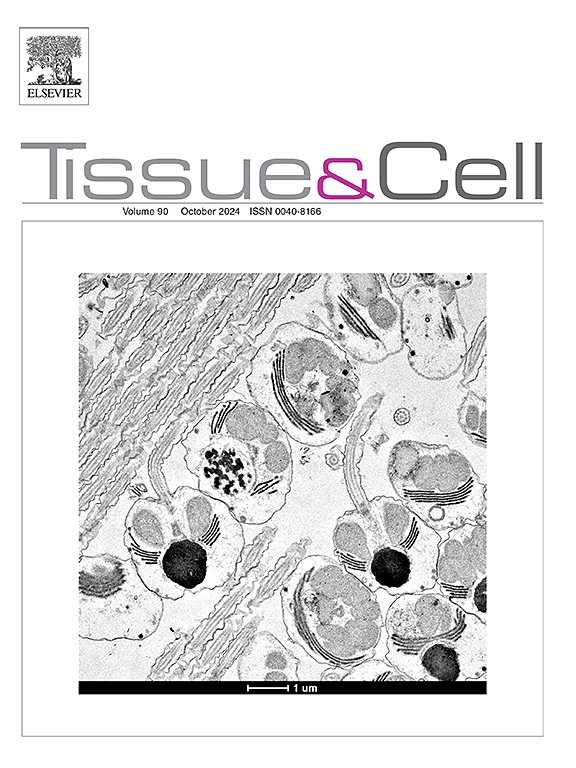Development of a biologically-inspired airway epithelial model using a bronchial decellularized scaffold: Applicability for pulmonary preclinical studies
IF 2.7
4区 生物学
Q1 ANATOMY & MORPHOLOGY
引用次数: 0
Abstract
The search for physiologically relevant 3D airway models in vitro has made significant progress in recent decades. The goal has been to replace animal-based methods with assays that mimic the human response to toxicants exposure through inhalation. However, replicating the entire composition of the extracellular matrix (ECM) microenvironment has proven challenging. Some strategies, such as 3D bioprinting and commercial hydrogels and biomatrixes, have addressed this issue. Yet, it remains difficult to recreate tissue topography, the location of anchorage proteins, and the exact protein and non-protein composition of ECM. In this study, we aimed to obtain and characterize a low-cost decellularized bronchial porcine scaffold derived from food industry waste. This scaffold was intended for the reconstruction of 3D bronchial models using human cells for long-term cultivation. Fragments from the main right and left bronchi underwent various matrix decellularization methods, including surfactant solutions, osmotic gradient, and nuclease treatment. The results showed that all these approaches efficiently promoted cell removal while preserving collagen content, glycosaminoglycans, and the basal membrane. Next, we repopulated the decellularized ECM (dECM) with Calu-3 epithelial cells and cultivated them in an air-liquid interface (ALI) to assess cell behavior within the scaffold. Over 7 and 14 days of ALI cultivation, the cells exhibited progressive growth on the bronchial dECM, expressing regular pan-cytokeratin, MUC1, and E-cadherin. In summary, we successfully developed a low-cost, biologically relevant dECM that was employed for reconstructing human airway models. These models hold promises for use in preclinical respiratory research studies.
使用支气管脱细胞支架开发生物启发气道上皮模型:肺临床前研究的适用性
近几十年来,寻找与生理相关的体外三维气道模型取得了重大进展。其目标是用模拟人体对吸入有毒物质的反应的测定方法取代基于动物的方法。然而,复制细胞外基质(ECM)微环境的整个组成已被证明具有挑战性。一些策略,如3D生物打印和商业水凝胶和生物基质,已经解决了这个问题。然而,重建组织地形、锚定蛋白的位置以及ECM的确切蛋白质和非蛋白质组成仍然很困难。在这项研究中,我们旨在获得并表征一种低成本的脱细胞猪支气管支架,该支架来源于食品工业废物。该支架用于使用长期培养的人类细胞重建3D支气管模型。来自主左右支气管的碎片经过各种基质脱细胞方法,包括表面活性剂溶液、渗透梯度和核酸酶处理。结果表明,所有这些方法都能有效地促进细胞的去除,同时保留胶原蛋白含量、糖胺聚糖和基膜。接下来,我们用Calu-3上皮细胞重新填充脱细胞ECM (dECM),并在气液界面(ALI)中培养它们,以评估支架内细胞的行为。ALI培养7天和14天后,细胞在支气管dECM上呈进行性生长,表达规律的泛细胞角蛋白、MUC1和E-cadherin。总之,我们成功开发了一种低成本的、生物学相关的dECM,用于重建人类气道模型。这些模型有望用于临床前呼吸研究。
本文章由计算机程序翻译,如有差异,请以英文原文为准。
求助全文
约1分钟内获得全文
求助全文
来源期刊

Tissue & cell
医学-解剖学与形态学
CiteScore
3.90
自引率
0.00%
发文量
234
期刊介绍:
Tissue and Cell is devoted to original research on the organization of cells, subcellular and extracellular components at all levels, including the grouping and interrelations of cells in tissues and organs. The journal encourages submission of ultrastructural studies that provide novel insights into structure, function and physiology of cells and tissues, in health and disease. Bioengineering and stem cells studies focused on the description of morphological and/or histological data are also welcomed.
Studies investigating the effect of compounds and/or substances on structure of cells and tissues are generally outside the scope of this journal. For consideration, studies should contain a clear rationale on the use of (a) given substance(s), have a compelling morphological and structural focus and present novel incremental findings from previous literature.
 求助内容:
求助内容: 应助结果提醒方式:
应助结果提醒方式:


